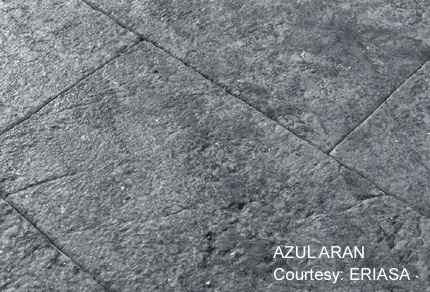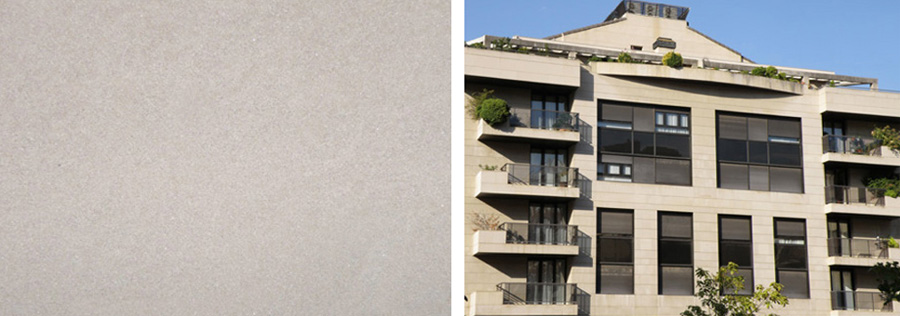Most people consider the natural stone industry in Catalonia to be a market and very few, even within the industry, think of it as a significant production centre or one with its own local stones. Someone visiting the elegant city of Barcelona immediately realises the extensive use of a wide variety of natural stones in all kinds of applications, whether cladding façades, interiors or public squares. Well, yes, there is also a local industry and in fact there are some local stones with potential not only in the Catalan market but also worldwide. We are referring to stone quarried in Catalonia (and mainly processed in Catalonia) but sold for all kinds of applications in countries of the European Union, the United States or the Gulf area. This report highlights the significant Catalan stone industry.
The Catalan stone extraction industry is located in three main areas: Ulldecona (Tarragona), around Vinaixa (Lleida) and San Vicente de Castellet (Barcelona).
ULLDECONA OR CENIA STONE
Ulldecona stone, from the town in the province of Tarragona where the quarries are located, is also popularly known as Cenia stone and there are a total of three quarries in operation. It is a sedimentary limestone, very hard, recrystallised by metamorphosis, which is why it can be classified as marble. It has been quarried for over a hundred years, but it is only in the last 30 to 40 years that the whole extraction process has been mechanised.
There are three companies with active quarries at the moment, dedicated to the extraction and production of Cenia stone in this area. They are as follows:
INMAR: The amount of stone extracted by this company is around 12,000 to 13,000 cubic metres per year, depending on market demand.
MARBRES CASTELL: The annual extraction is around 15,000 cubic metres.
MARBRES HOMEDES.
Currently there are significant reserves that guarantee the supply of this material.
Ulldecona stone comes in two shades: Cenia Beige and Cenia blue or grey.
Different finishes of Ulldecona stone. Photos courtesy MARBRES CASTELL
Finishes and applications
The most common finishes are flamed, bush-hammered, honed, aged, brushed, rustic and sandblasted, or simply cut. This material is also polished, but only for indoor use.
More than 80% is used outdoors for façades, floors, balustrades, fountains, etc. and in public works such as the paving of the streets of Formentera, It is also widely used for the renovation and restoration of buildings such as the Castle of Peñíscola or some of the floors of the rooms of the Prado Museum. Indoors it is also used for flooring and stairs.
Markets
In addition to the Spanish market (between 40% and 50% of production and falling), these three companies have managed to sell Ulldecona stone to France, Belgium, the United Arab Emirates, the United States and Japan. The fact that this material is similar to some French stones such as Buxiy or Hauteville, together with the fact that it is very competitively priced, has been of great help when it comes to opening up new markets, especially the French market. Around 50% or 60% of production is sent outside of Spain.
FLORESTA STONE - VINAIXA STONE
The quarries are located in the province of Lérida, in different areas of the region of Las Garrigas such as Juneda, Els Omellons, La Floresta and Espluga y Calva. There are about six quarries of this material. The production capacity of all the quarries together is estimated at 1,500 - 2,000 cubic metres per month.
Although it was only 35 years ago that industrial-scale quarrying began, this type of stone has been quarried for over a century. In fact, some of the youngest people in today's companies are fourth-generation sandstone quarrymen.
The companies that extract and also produce Floresta sandstone, although with different commercial names depending on the areas of extraction and colour, are:
GERMANS BALAGUE: Under the name of Piedra Juneda.
PEDRERES INCOMAR: Beige Incomar.
PEDRES MAGAMI
PIEDRA MORAGUES
RUBIO STONE: Under the name of Piedra Brisa and Piedra Clara.
SÁEZ SANDSTONE: Floresta Castellots, Floresta Omellons and Floresta Marrón.
It is a sandstone that is generally light brown with grey tones, fine grain, not very dense, uniform, without veins and easy to work.
Floresta stone. Photo courtesy RUBIO STONE
Finishes and applications
This material cannot be flamed. The finishes it accepts are sawing, honing, bush-hammering, ageing, polishing, scarifying, stoning, sanding and rusticating.
It is widely used for outdoor paving because it withstands wear and tear and adverse weather conditions very well, on facades and cladding. In recent years it has become a very popular material in the northeast of Spain.
Markets
Its main market is in the north of Spain, but it is also sold in the rest of the country and exported both in slabs and cut to size to France, Italy, the United Kingdom, Central and Eastern Europe and to more distant markets such as Argentina, Australia and Japan.
SAN VICENTE OR SANT VICENÇ LIMESTONE
The third important stone quarried in Catalonia is known as San Vicente or Sant Vicenç stone. Its quarries are located in the area of Sant Vicenç de Castellet, in the province of Barcelona, and this grey-green material is composed of calcium carbonate, with quartz, silica and magnesium carbonate. This area can be considered the heart of the stone industry in Catalonia.

Limestone San Vicente. Photo courtesy CANTERAS VALSAN
There are three companies with quarries of this limestone. As in other areas, the industrial exploitation of this limestone has only taken place in the last 30 years. Some of the companies that work with this stone are:
CANTERAS VALSAN
MÁRMOLES MORATONAS: Their Sant Vicent limestone has the commercial name Moon Grey and, depending on the colour, even when from the same quarry, is called Girona Moon and Ros Moon. They have an annual production of around 5,000 m3, depending on orders. Apart from the domestic market, it exports to France, Italy, Germany, the Nordic countries, the UK, North America, the Middle East and, more recently, Australia.
ISISTRIVA
Finishes and Applications
The standard finishes are honed, bush-hammered, sandblasted, aged and brushed, as well as polished and cut. Depending on the quarry, flamed finishes are sometimes available. The colour of this stone is practically uniform, what can vary is the polish of the surface. Material from quarries with a high level of carbon cannot be polished.
The polished finish is used indoors, the other finishes are for outdoors.
It is a very hard limestone with extreme resistance, very suitable for places with a lot of traffic.
Markets
This stone has been used throughout Spain, as well as in France and the Benelux countries. It is similar to a Belgian limestone called PETIT GRANIT, which has facilitated sales efforts in these markets for companies working with this stone.
AZUL ARÁN GRANITE

This is the only granite quarry in Catalonia. It is located specifically in the Val d'Aran, in the northeast of the Pyrenees (Lleida). The annual extraction of this material, together with that of Eragón brown shale, which comes from the same quarry, is around 600-800 m3 per year. The current owner of the quarry is the Italian company Nikolaus Bagnara S.p.A.
The extraction of the blocks is carried out by the Spanish company Azul Arán and the transformation of the material and subsequent export is carried out from Italy. Its main markets are Central Europe, China and Australia.
As with most granites, it allows for all finishes, satin, sandblasted, brushed, although polished and flamed are the most popular.
It is a bluish-coloured rock, named after the blue-grey colour of its coarse-grained feldspar combined with white tones. Depending on the finish applied, the colour looks different, with some tones standing out more than others.
Due to its relatively high price, its main application is in interiors, it is especially suitable for kitchen worktops, and for both interiors and exteriors it is applied to flooring, facades, walls, etc.
OTHER STONES
Apart from those mentioned, there are other stones in Catalonia, although they are extracted in small quantities. Some of them are listed below:
-San Vicente is available in small quantities in the San Vicente de Castellet area. This stone is mainly marketed in cut and bush-hammered finishes.
-In El Fígaro (Barcelona) there is a red sandstone, which comes in slab format and is used for landscaping and gardens.
- Green sandstone in Folgueroles (Barcelona). Bluish-green in colour, it is used in exterior decoration and can be supplied flamed and polished. There are three quarries.
- Another type of stone from Gerona is known as Banyoles Stone. It is no longer quarried, only reserves remain.
The material called Piedra Licorella is found in Ayguafreda, Barcelona, and is used for paving, cladding and garden slabs. It has a rustic texture and can be grey, blue or rusty in colour. It belongs to the slate family. It is produced in irregular 3-4 cm tiles.
In Montseny (Barcelona) there is a black slate that is mined in small quantities,
NOTE: article updated in April 2025


